Test: Design Of Clutches And Brakes (Level - 3) - Mechanical Engineering MCQ
20 Questions MCQ Test - Test: Design Of Clutches And Brakes (Level - 3)
A drum brake is shown in the figure. The drum is rotating in clockwise direction. The coefficient of friction between drum and shoe is 0.25. The brake torque carrying capacity is 100 Nm. The actuating force P in N is __________.
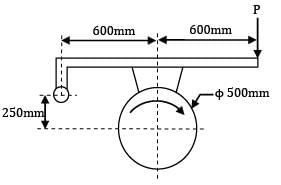

Assertion (A): In case of friction clutches, uniform wear theory should be considered for power transmission calculation rather than the uniform pressure theory.
Reason (R): The uniform pressure theory gives a higher friction torque than the uniform wear theory.
In a multiple disc clutch, the axial intensity of pressure is not to exceed 0.2 MPa. The inner radius of the disc is 100 mm and is half the outer radius. The axial force per pair of contact surfaces is
A single plate clutch consists of one pair of contacting surface. It is used for an engine, developing maximum torque of 200 Nm. Assume factor of safety as 2 at full engine torque. What is the inner diameter of friction lining, if the ratio of outer diameter to inner diameter of lining is 2? Permissible pressure intensity is 350 kPa and coefficient of friction is 0.3. (Assume uniform wear theory)
The block brake shown in figure has a face width of 50 mm. Find the value of force at the end of lever. Take permissible bearing pressure 0.5 MPa and coefficient of friction 0.3.
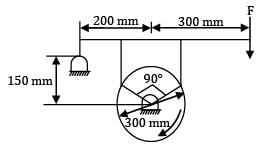
In a single plate disk clutch the outer diameter is twice the inner diameter, the ratio of torque transmitted in uniform pressure theory to uniform wear theory assuming same axial load in both case is
(A) 2/3
(B) 4/3
(C) 28/27
(D) 3/4
A band brake consists of a lever attached to one of the end as shown in below figure. The other end of the band is fixed to the ground and coefficient of friction between band and the wheel is 0.5. The maximum tension that can be generated in the band during braking is

A braking torque of 80 N-m is applied for 5 sec to bring the shaft rotating at 100 rpm to rest. The heat generated is __________ kJ.
The band brake shown at 3/4th of the circumference of a drum of diameter 450 mm, and provides a braking torque of 225 Nm. If coefficient of friction is 0.25, what is the operating force P (in N), when the drum rotates in anticlockwise direction?\

A plate clutch consists of one pair of contacting surfaces and transmits 20 kW power at 750 rpm. The ratio of outer diameter to inner diameter is 2. The coefficient of friction is 0.2 and the permissible intensity of pressure is 1 N/mm2 . According to uniform wear theory, the inner diameter is
A plate clutch consists of two pairs of contacting surfaces with asbestos friction lining and has the following parameters:
Outer diameter of friction lining = 300 mm
Inner diameter of friction lining = 150 mm
Coefficient of friction = 0.45 .
Maximum engine torque = 220 Nm
The clamping force is provided by 8 springs, each give a force of 600 N. The factor of safety with respect to slippage after initial wear has occurred is
Shown in the figure is a single block brake. The intensity of pressure between the block and brake drum is 1.5 N/mm2 . The dimension of block is 40 mm X 80 mm. The coefficient of friction is 0.25. What is the value of hinge pin reaction for clockwise rotation of the drum?
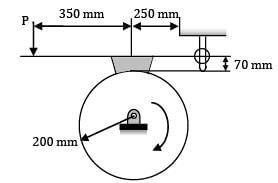
A band brake having band width of 90 mm, drum diameter of 300 mm, coefficient of friction 0.3 and angle of wrap 270o is required to exert friction torque of 1200 Nm. The maximum tension developed in the band is __________ kN.
A plate clutch consists of single pair of contacting surface. The ratio of outer diameter to inner diameter is 2. The coefficient of friction is 0.15 and the permissible intensity of pressure is 1.5 N/mm2 . The maximum torque transmitting capacity of clutch is 250 Nm. The inner diameter of plate clutch using uniform pressure theory is __________ mm
A multi-disc friction clutch is used for transmitting torque of 100 Nm. The permissible intensity of pressure on the friction lining is 600 kPa. The coefficient of friction is 0.2. The outer and inner diameter of friction lining is 100 mm and 50 mm respectively. Assuming uniform wear theory, the required number of discs are
For uniform wear theory the ratio of inner radius to the outer radius for maximum torque transmission in a disc clutch will be __________.
The maximum tension in belt is 800 N, angle of wrap is 180o and tension ratio is 2 as shown in figure, then braking effort required in the simple brake when drum is rotating in clockwise direction is
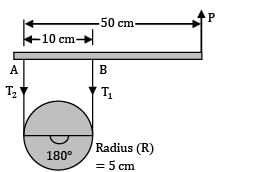
A plate clutch consists of one pair of contacting surfaces and transmits 20 kW power at 750 rpm. The ratio of outer diameter to inner diameter is 2. The coefficient of friction is 0.2 and the permissible intensity of pressure is 1 N/mm2. Assuming uniform wear theory, calculate the inner and outer diameters.
A differential band brake is shown in figure. The angle of contact is 280O. The brake is to sustain a torque of 500N-m. The brake drum diameter is 500 mm. The coefficient of friction is 0.3, the effort, P is
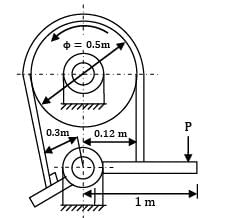
A differential band brake as shown in figure has torque capacity of 3000 N-m. The thickness of the steel band is 3 mm and the maximum tensile stress in the band is 50 N/mm2 between the friction lining and the brake drum is 0.25. The width of the band is ________.. The coefficient of friction
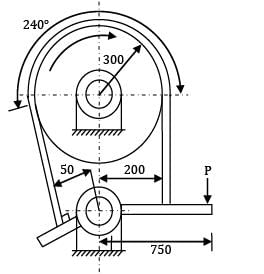


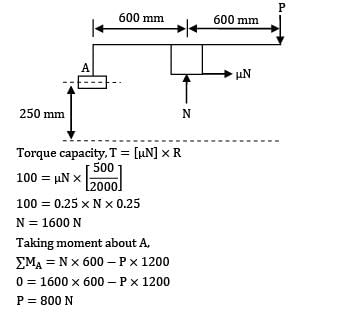
 MA = N x 600 - P x 1200
MA = N x 600 - P x 1200
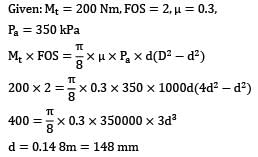
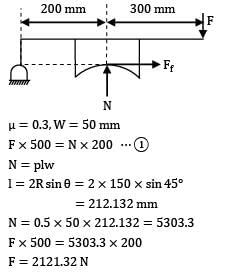
 = 2 x 150 x sin 45o
= 2 x 150 x sin 45o ro = 2ri
ro = 2ri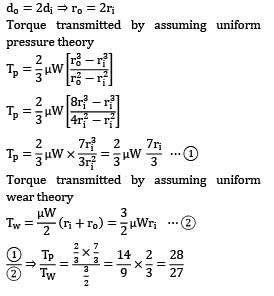
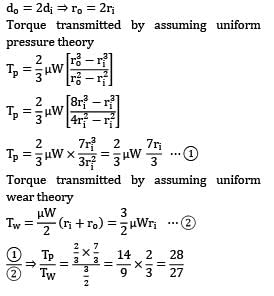
 = 270o,μ = 0.5
= 270o,μ = 0.5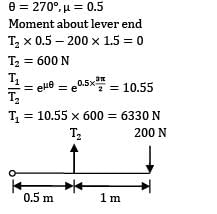

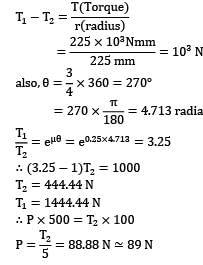
 T2 = 1000
T2 = 1000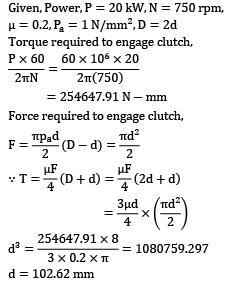
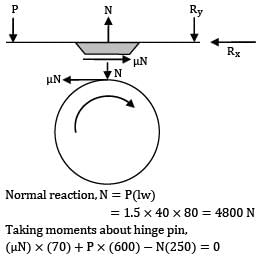
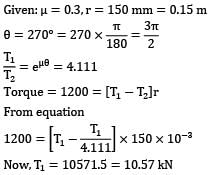

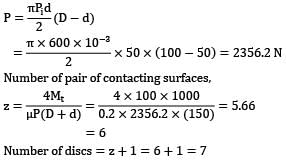
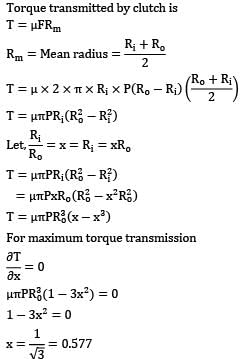

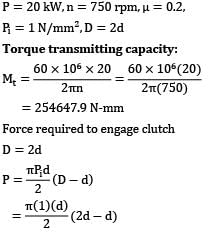
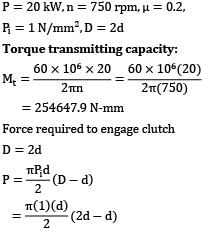

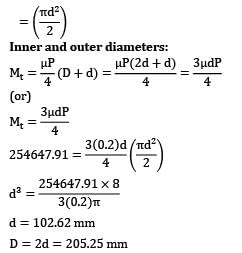
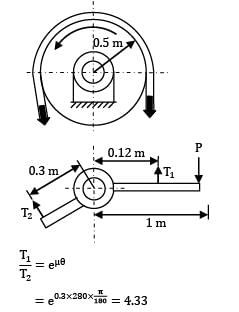
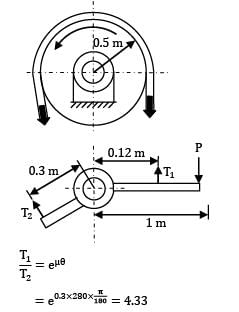
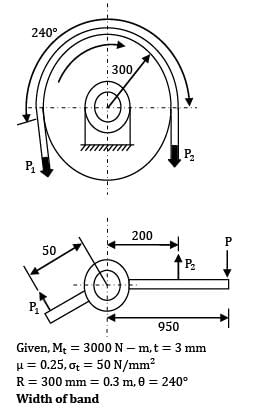
 t = 50 N/mm2
t = 50 N/mm2 = 240o
= 240o twt
twt










